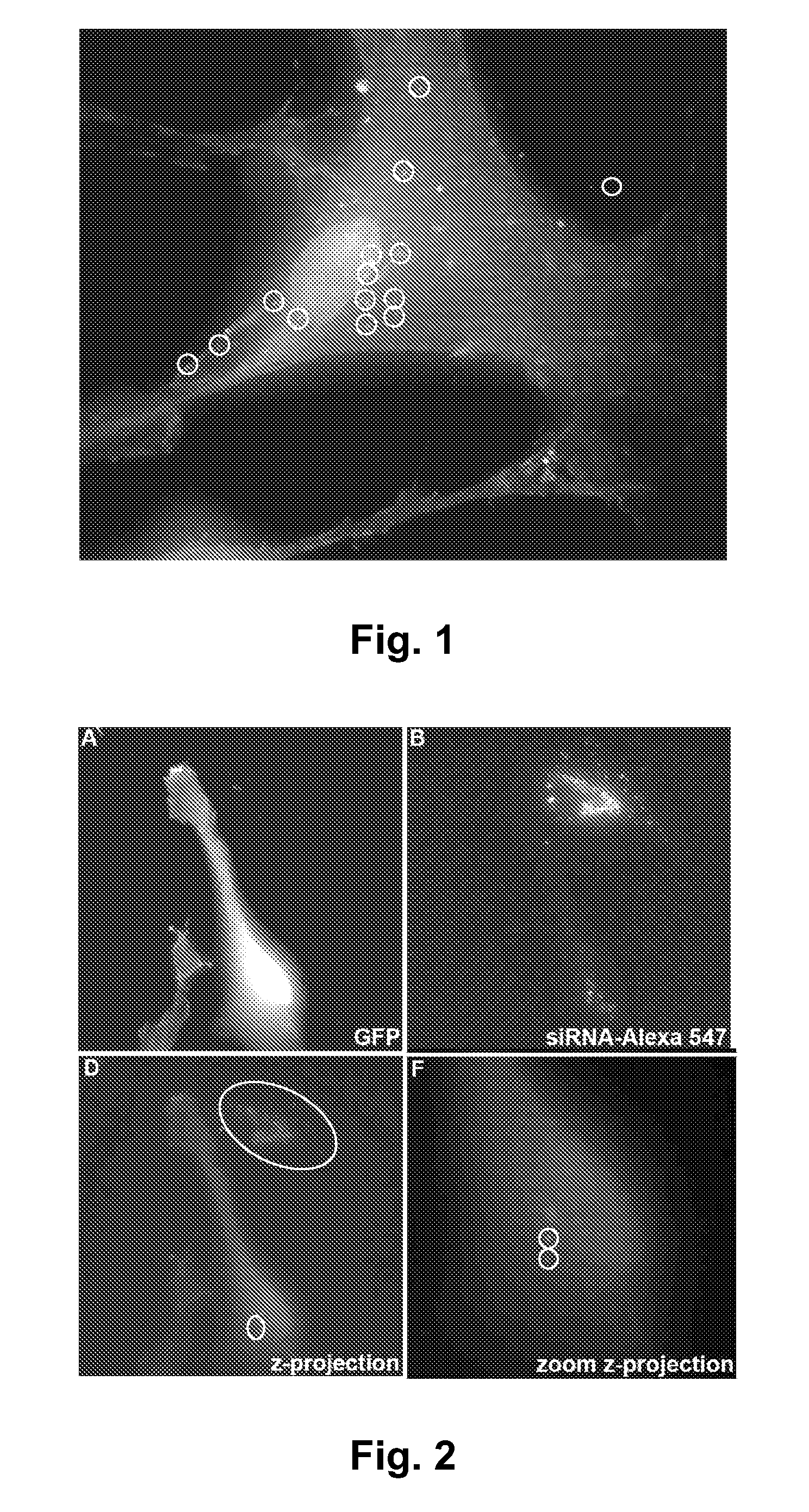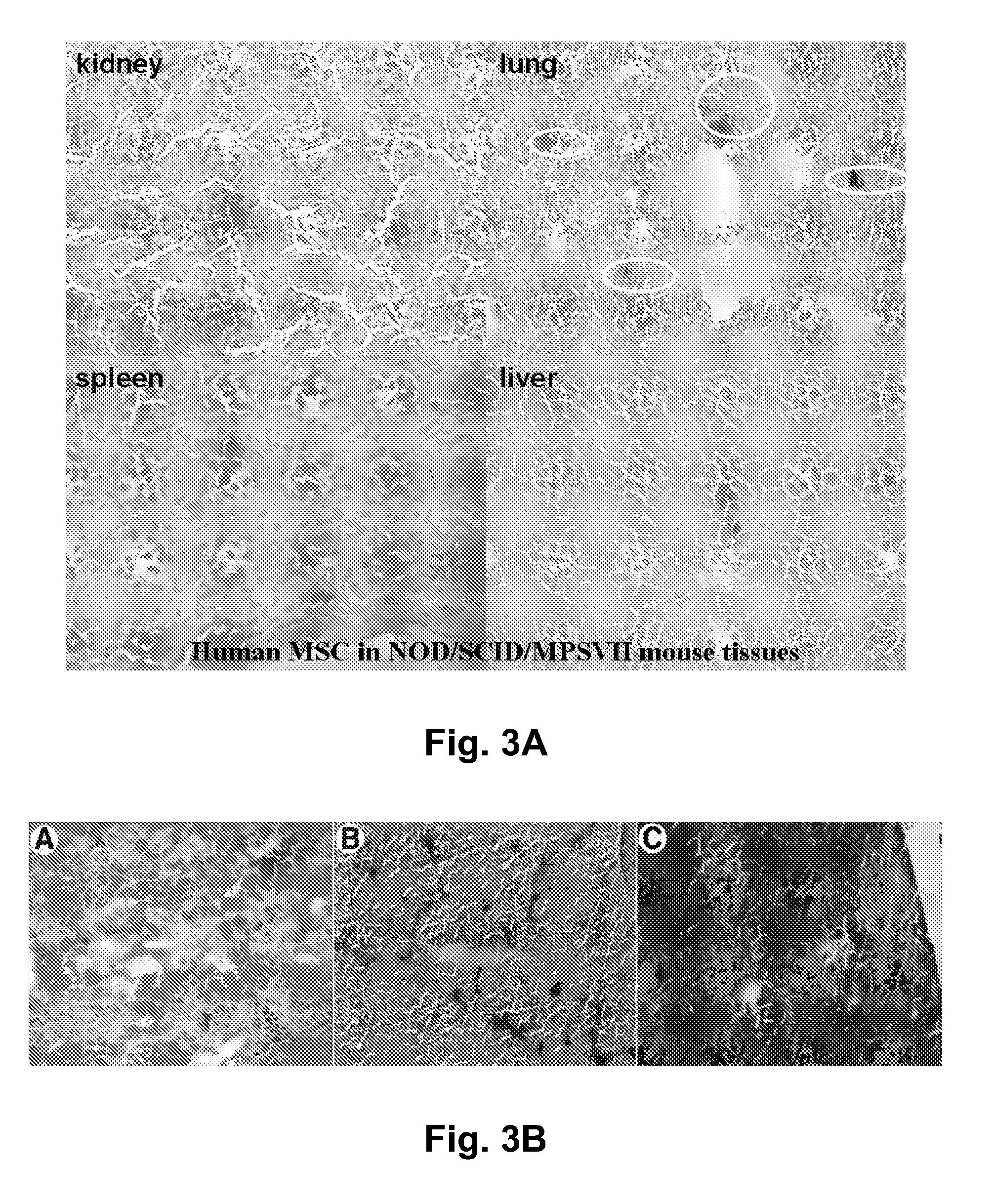Mesenchymal Stem Cells Producing Inhibitory RNA for Disease Modification
- Summary
- Abstract
- Description
- Claims
- Application Information
AI Technical Summary
Benefits of technology
Problems solved by technology
Method used
Image
Examples
experimental examples
Example 1
MSC Infuses siRNA to Target Cells
[0151]It is discovered that MSC can be used deliver siRNA robustly into damaged cells in vivo. FIG. 1 shows an eGFP-labeled MSC that has had alexa-fluor-labeled anti mutant htt siRNA (red) transferred into it from an adjacent, non-GFP MSC (see also FIG. 3). Brighter spots have coalesced into lysosomes after transfer, but smaller siRNA amounts are scattered throughout the cytoplasm and nucleus. Human mesenchymal stem cells (MSC) can be transduced to produce siRNA and other RNA-modifying moieties (siRNA / miRNA hybrids and others), to reduce levels of mutant htt RNA and protein levels in neurons.
[0152]It is discovered that MSC will readily transfer the small RNA molecules directly through cell-to-cell contact. The cell-to-cell contact may include cellular protrution, cytoplasmic extension, or tunneling nanotubes. It has been demonstrated that MSC's rapidly home to the site of injury or distress in the body. MSC's survive integrated into the tiss...
example 2
MSC Isolation and Transduction
[0154]Human MSC can be collected from normal donors and expanded under clinically relevant conditions. Applicants have previously demonstrated that human MSC readily uptake viral vectors (see, e.g., Dao et al. (1997) Stem Cells. 15:443-454; Meyerrose et al. (2007) Stem Cells. 25:220-227; Meyerrose (2008) Stem Cells. 26:1713-1722; and Nolta (1994) Blood. 83:3041-3051). Lentiviral vectors have been developed to express several different forms of the mutant htt protein for direct injection into the left and right striata, for development of an HD mouse on the permissive xenograft background. Coding sequences in these vectors included the
[0155]Htt cDNA coding for amino acids 1-400 with CAG repeat lengths of 18 (wild-type, normal gene), 44, and 82. Introduction of the gene with 82 repeats caused rapid onset of inclusion formation and behavioral deficit when introduced in rodents using the viral vector strategy as described, with a 1-3 week delay caused by th...
example 3
Allele-Specific siRNA
[0156]The goal of siRNA knockdown in HD is to suppress the mutant protein while sparing mRNA transcribed from the normal allele. Schwarz et al., in 2006, first demonstrated that allele-specific suppression of huntingtin mRNA expression was possible (Schwarz et al. (2006) PLoS Genet. 2:e140). van Bilsen et al. demonstrated allele-specific suppression of endogenous huntingtin gene expression in cells isolated directly from Huntington's disease patients (van Bilsen et al. (2008) Hum Gene Ther. 19:710-719). van Bilsen et al. have determined SNP sites to target that are located remotely from the CAG repeat region. The siRNA known to reduce the mutant gene can be introduced into the mice, directed to SNP rs363125, with 44 CAG codons versus 19 CAG codons on the wild-type allele. A vector to express the sequence identical to siRNA 363125_C-16 as tested in van Bilsen's study has been created and a specific siRNA vector for the 82 repeat Htt allele can be utilized. It is ...
PUM
| Property | Measurement | Unit |
|---|---|---|
| Composition | aaaaa | aaaaa |
| Inhibition | aaaaa | aaaaa |
Abstract
Description
Claims
Application Information
 Login to View More
Login to View More - R&D
- Intellectual Property
- Life Sciences
- Materials
- Tech Scout
- Unparalleled Data Quality
- Higher Quality Content
- 60% Fewer Hallucinations
Browse by: Latest US Patents, China's latest patents, Technical Efficacy Thesaurus, Application Domain, Technology Topic, Popular Technical Reports.
© 2025 PatSnap. All rights reserved.Legal|Privacy policy|Modern Slavery Act Transparency Statement|Sitemap|About US| Contact US: help@patsnap.com


